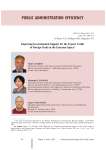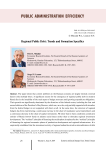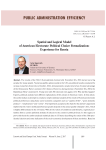Public administration efficiency. Рубрика в журнале - Economic and Social Changes: Facts, Trends, Forecast

Improving governmental support for the export credit of foreign trade in the Eurasian space
Статья научная
The development of common approaches to the provision of governmental support to export credit within the Eurasian Economic Space streamlines the entry of national producers into foreign markets and the development of foreign trade. The paper aims to justify the need to harmonize the rules according to which the government provides support to foreign trade within the Eurasian Economic Union (EAEU). We analyze principles for determining the minimum rates on export credits (CIRR, Commercial Interest Reference Rates) in national currencies, describe a methodology for determining the value of CIRR and calculating the minimum premium for credit risks adopted by the OECD, and define basic conditions for the provision of related export financing in the OECD. The novelty of our research consists in the fact that we calculate CIRR for EAEU member states in their national currencies in accordance with the provisions of the OECD Arrangement on Export Credits. The calculation technique that we propose contributes to the establishment of harmonized conditions to support the export of industrial products within the EAEU...
Бесплатно

Regional public debt: trends and formation specifics
Статья научная
The paper shows that current problems in the Russian economy are largely internal; external factors only multiply them. A significant reason for the emergence of regional public debt in modern Russia lies in the instability of the main types of budget revenues amid growing expenditure obligations. Their growth was significantly dominated by the directives of the federal center, including the first and second editions of the President’s May Decrees, which are, as a rule, only partially supported with transfers from the federal budget or not supported with them at all. At the same time, the structure of regional budgets has been experiencing a continuous increase in the share of mandatory social expenditures and a continuous decrease in the share of capital investments. We show that in these conditions constituent entities of Russia borrow funds to address social issues rather than to stimulate regional investment development. The “residual” principle of financing the social sphere is replaced by the “residual” principle of financing the regional economic sphere of production development and regional infrastructure. It is empirically established that the investment activity of regional authorities involves intensification of debt activity. Having compared the volume and dynamics of debt obligations of Russia’s constituent entities with the provision of expenditures with budget revenues we see that the rapid growth of debt obligations of the authorities of Russia’s constituent entities and the increase in the debt burden on sub-federal budgets pose an actual threat to the stability of territorial budget systems and economic security of regions and the state. We show that territorial convergence of regional public debt in the context of federal districts hides the territorial divergence of regional debt that has increased under the load of obligations to implement the May Decrees and under the lingering and extremely high differentiation of regional budget revenues.
Бесплатно

Статья научная
The results of the 58th US presidential election held November 8th, 2016 turned out a big surprise for many people. Numerous public opinion polls in the USA on political loyalty conducted by various researchers from July to October, 2016, demonstrated a steady trend of an electoral advantage of the Democratic Party's nominee (H. Clinton). However, during election (November 8th, 2016) the Republican Party's nominee D. Trump won with 306 electoral votes against 232. Why did this happen? Experts, political analysts have different explanations of this choice of American voters. In this article, the author makes an attempt to conduct a simple statistical analysis of the results of American electorate political preferences using basic socio-economic categories such as “quality of life”, “gross domestic product”, “employment” and “crime”. The hypothesis accepted as the basis for the author's arguments implies that the voters' political preferences greatly depend on the actual quality of people's lives, which is highly differentiated in the US states...
Бесплатно

